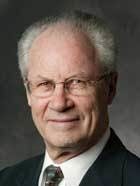Stockholm Water Prize Winner McCarty Takes a Bow
by Carlos David Mogollón, Managing Editor
After earning his doctorate from Boston’s M.I.T. in the late-’50s, Prof. Perry McCarty headed west where he spent almost his entire career at Stanford University’s Department of Civil & Environmental Engineering. The year was 1962. On Oct. 14, he’ll address WEFTEC.07 attendees in San Diego as keynote speaker.
Theories McCarty developed in the intervening years regarding biological and chemical water and wastewater treatment, particularly in the design of anaerobic processes and bioreactors, have had a broad impact on small- and large-scale safe drinking water and pollution control systems - municipal and industrial.
For this research, he was announced on World Water Day on March 22 as winner of the Stockholm Water Prize, which will be awarded in August in Sweden at World Water Week festivities hosted since 1991 by the Stockholm International Water Institute.
McCarty’s efforts to determine suspended solids retention time without quantifying bacteria led to work with different microorganisms, which led to studies on how biofilms assist in clarifying water, sludge processing and additional breakthroughs on how potentially harmful contaminants could be broken down via bioremediation processes to their less harmful constituent compounds.
He hesitates to single out others for credit with so many worthy, but mentions a Manhattan College researcher for work with fluidized bed reactors and a Dutch researcher’s work on upflow anaerobic sludge blanket reactors (UASBR) as significant milestones. Another involves more recent methods of recapturing methane gas and biosolids from wastewater for reuse as an energy source.
The professor also was involved in California’s Orange County Water District and its Water Factory 21 effort on groundwater reinjection of treated wastewater for later withdrawal and reuse as a potable source. Still, he noted, protecting groundwater is crucial worldwide as it’s 98% of liquid freshwater and 50% of people use it for drinking water. Also, unlike surface water, its containment areas - aquifers - once polluted take vastly longer to recover.
Click here to read "An Interview with 2007 Stockholm Water Prize Winner, Prof. Perry McCarty" in full in Q&A format.

